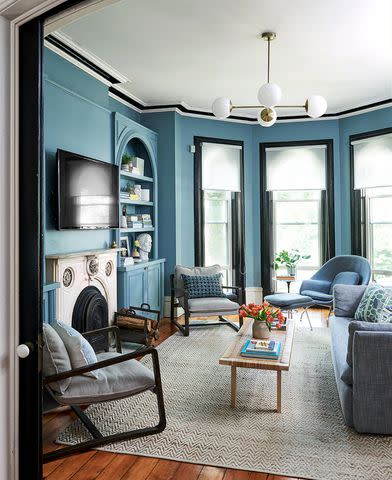6 Decorating Mistakes That Make Your Home Look Messier

Steer clear of these six decorating mistakes for a polished look that still feels cozy, comfortable, and inviting.
You work hard to keep your home clean on a daily basis, so the last thing you want is for your decorating choices to contribute to a messy-looking room. Although clearing out clutter is always the first step to a polished, orderly look, the way you furnish and decorate a room is also critical to its overall neatness. Simple decorating mistakes can make a space appear disheveled or downright chaotic, thwarting your efforts to create a relaxed mood. Luckily, an over-decorated house is usually easy to fix with a few tweaks—removing or swapping out accessories or rearranging the furniture can help bring a sense of order to the room.
To help you create a space that looks clean and organized, we've compiled a list of decorating mistakes that might be making your home appear messy. By avoiding these common missteps, you'll find your rooms will look more tidy and inviting.

1. Crowding Open Shelves
Open shelves are a great place to store books and display collectibles or art, and they can give a room a much-needed focal point, but this type of storage works best when it's not overcrowded. When styling a bookcase or built-in shelves, don't pack every inch of space with books and accessories. Instead, edit down the arrangement to leave some open space between items. Also, open shelves are not the best place for electronics and cables—all those black boxes and cords will detract from the accessories you are displaying. If you need to store games, movies, toys, or anything else with multiple smaller parts, stash them away in matching baskets or shelf-worthy boxes, like these lidded hyacinth boxes, $13.88 each, from the Better Homes & Gardens Collection at Walmart.
Zigzag Your Shelves
When styling shelves, arrange the larger, darker items in a zigzag pattern from shelf to shelf in order to distribute the visual weight evenly across all the shelves. For example, land something visually heavy in the lower right corner, the left side of the middle shelf, and the far right corner of the top shelf. Fill in the open spots with smaller, visually lighter items.

2. Using Too Many Colors
Decorating with many different colors—especially on the large surfaces like walls and furniture—can make a home look cluttered. Instead, stick to one or two hues combined with neutral colors to give your home a cohesive, relaxed look. This living room features various shades of blue to create a calming, pulled-together space. The neutral rug, window coverings, and solid-color furnishings—all in blues and grays that blend with the cadet blue wall color—allow the room to breathe while making it appear more spacious and open.
Add a Touch of Black
Decorating pros swear by the idea that every room needs a bit of black. It draws the eye, gives it a place to rest, and makes the room look visually more crisp. Try bringing in black on the frame of a chair, a side table, picture frames, a light fixture, or even trim.
Related: 33 Living Room Color Schemes for a Beautiful, Livable Space

3. Adding Too Many Throw Pillows
Avoid a haphazard and untidy look by limiting the number of throw pillows on a sofa or bed. This living room includes quite a bit of pattern and color but still looks tidy partly because the sofa isn't laden with piles of decorative pillows, and the ones that are there work together because they share a graphic black and white design. Usually, two or three pillows on each end of the sofa are enough to bring in some color and pattern that give visual interest without overwhelming. For a more visually quiet approach, choose throw pillows in neutral and/or solid colors that have interesting texture.

4. Pushing Furniture Against Walls
Arranging your furniture up against the walls can make a room look cluttered and messy. Seeing all those large silhouettes against the walls can draw too much attention to each individual piece, when what you really want is for them to all sort of visually blend together into a harmonious grouping. The solution? Try pulling the furniture away from the walls and toward the center of the room. This grouping of four chairs around a coffee table creates a nice conversation area. The fact that the chairs and the walls are both white helps the room look clean and tidy. A blue rug and matching blue throw pillows grounds the floating seat grouping and ties it together. If your rug is not large enough for the furniture to fit entirely on it, at least make sure the front legs of all furniture fit on the rug.
Related: 20 Living Room Furniture Layouts That Make the Most of Your Space

5. Displaying Too Many Accessories
Too many decorative accents on the surface of a table will make a room look cluttered. Instead try grouping smaller items on a tray. Making sure to vary the size and scale of the items and not to crowd the tray. Display odd numbers of things together—three or five items rather than two or four. Another idea: Elevate small objects on a stack of two or three books to make it look intentional. Edit your accessories ruthlessly until you are only displaying items you truly love and/or that are functional and put the rest in storage so you can swap things out when you need a change.

6. Hanging Pictures Randomly
Wall art and/or photos hung in a haphazard fashion across a wall can look chaotic and overwhelming. The good news is that problem is easy to fix by creating a gallery wall. First, get all matching frames, or as close as possible—repetition always looks organized. Next, rehang the pieces so that together they make a simple, contained shape, like the square above the bed. Arrange the frames so there is a consistent amount of space, or a channel, around them. Hang the frames and stand back to appreciate the sense of balance and organization that a gallery wall can bring to a room.
For more Better Homes & Gardens news, make sure to sign up for our newsletter!
Read the original article on Better Homes & Gardens.
Solve the daily Crossword

